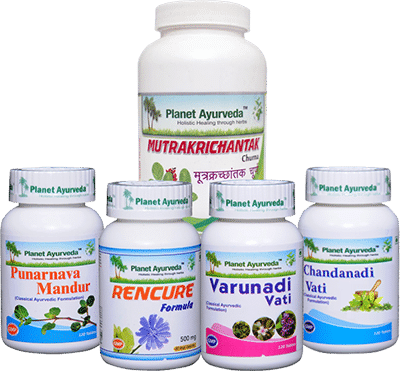Kidney Disease in Dogs and Its Treatment in Ayurveda
Abstract
Kidneys are vital organs of the body. They maintain the fluid quantity in the body and excrete the harmful toxins out of the body. As humans other organisms also have the kidneys for the same functions. Dogs are a different species but the functioning of the body is very similar to that of the human body. The kidney in dogs helps in the balancing of the minerals in the body and removes the toxins out of the body. The kidneys are prone to get damaged easily if one does not take good care of the kidney health and also hampers the function of the kidney and results in a number of worrisome symptoms. In this text, we shall discuss kidney disease in dogs and also have a look at its management in the contemporary veterinary sciences and the management that helps in the same. Let’s get started!!

Introduction
Kidney disease is a disease that affects the basic unit of the kidney that gives rise to a number of symptoms with the emergence of hampering the functions of the kidney cells. In dogs, kidney disease is associated with the age of the same or in other words, the kidney disease is related to the wearing out of the tissue of the kidney. The occurrence of the emergence of kidney disease depends on the size of the dog. For the small dogs the condition can arise in about ten to fourteen years of age. The larger ones have a smaller lifespan as they undergo kidney failure at about the age of seven years or so. Now let’s have a look at the causes, clinical features, investigations and management of the kidney disease in the dogs!!
Causes of Kidney Disease
- The kidney disease in dogs can be acute or chronic. Acute kidney disease can occur in a short period of time whereas chronic kidney disease occurs slowly over a period of time.
- The exact cause of chronic kidney disease is not known but certain infections are considered to be of great kidney unrest.
- Snake bites can result in severe allergic and nephrotoxic reactions.
- Heart stroke
- Leptospirosis
- Severe dehydration can lead to kidney failure
- Dental diseases are considered the leading cause of chronic kidney disease in the older dogs as the toxins from the mouth enters the body and results in infection.
- Certain medications also result in kidney disease due to their nephrotoxic nature.
- Congenital disease
- Geraitric degeneration
Types
There are two types of kidney disease as follows
Acute Kidney Disease
It is sudden onset renal failure. In this type, the appropriate treatment resolves the condition. Whereas if left untreated, it proves fatal.
Chronic Kidney Disease
This is most commonly found in older dogs. Early management slows the progression of the disease. Commonly when the patient starts showing the symptoms, the damage is done.
Signs and Symptoms
- Altered frequency and volume of urination
- Loss of interest in interacting and playing
- Diarrhoea
- Vomiting
- Unexplained loss of weight
- Blood in the urine
- Decreased appetite
- Dental diseases
- Drinking less or more water
- Depression
- Bad breath
- Ulcers in the mouth
- Intestinal seizures
- Blood in the urine
Investigations
- Blood work
- Urine specific gravity
- Blood urea nitrogen (BUN)
- Blood creatinine (CREA)
- SDMA concentration
- The IRIS (International Renal Interest Society) staging system to monitor the degree of the disease.
Management of Kidney Disease in Dogs
- Diuretics
- Fluid therapy
- Electrolyte addition
- Antiemetics
- Dialysis
- Nutritional support
Ayurvedic Aspect and Management of Kidney Disease in Dogs
Ayurveda is an ancient/traditional medicinal system of India. Ayurveda has been serving mankind from the ages perfectly. Ayurveda has two main objectives. One is maintaining the healthy status of healthy individuals and treating the diseased ones. Ayurveda defines the best treatment as the treatment that does not give rise to another complications or disease while managing the one. So this is what Ayurveda is all about and the excellence of the same. Ayurveda focuses on healthy eating and living a life according to the season running.
Coming to the ayurvedic veterinary system, there is no such correlation of the veterinary system mentioned but with the expertise in the same some ayurvedic experts have dealt with a number of animal diseases so nicely and positively and have mentioned about the same in their texts and literature. They have discussed the anatomy, physiology, pharmacology and treatment of certain veterinary diseases.
In India, animals are worshipped as many animals are considered as the vehicles of God and Goddesses. So taking care of them is indeed obvious and that also serves the purpose of humanity.
The correlation of kidney disease can be well established with the vrikka dosha. The condition is related to the vitiation of tridosha particularly pitta dosha that causes the inflammation of the kidney cells. The dushya are mutra (urine), rakta (blood), mamsa (muscle) and meda (adipose). The vitiated srotas are medovaha and mutravaha srotas.
The management of the condition depends on the pacification of the pitta dosha. And cleansing the microchannels of that are blocked due to the vitiated kapha dosha.
The ayurvedic medicines that are effective in kidney disease are chandraprabha vati, shilajit, gokshuradi guggulu, vasttamayantaka ghrita, shilajit lauha, brihatyadi kashyam, amalaki rasayan, shatavari churna, trivrit lehya, triphala churna etc.
Herbal Remedies for Kidney Disease in Dogs by Planet Ayurveda
Planet Ayurveda is an eminent ayurvedic unit and US-FDA registered and ISO 9001:2015 certified company. Planet Ayurveda’s objective is to provide health to all with Ayurveda and spread the wisdom of Ayurveda globally. Planet Ayurveda composes products of different types in different forms such as vatis (tablets), asavarisht (syrups), capsules, churna (powders) and lehya (jams). These products are free from any sort of adulterants and chemicals. The products are formulated as per the classical Ayurvedic texts and Indian pharmacopoeia. Planet Ayurveda’s products are so pure and devoid of artificial sweet enhancers, chemicals and additives etc. Planet Ayurveda has come up with its products that are consumables by humans and animals as well. And the products are so effective as they are made up of pure herbal extracts. Planet Ayurveda extends its products for the management of kidney disease in dogs. Let’s have a look at the products that are helpful in the management of kidney disease.
The following are the herbal formulations of Planet Ayurveda that helps in managing the Kidney Disease in Dogs
Product Description
1. MUTRAKRICHANTAK CHURNA
Mutrakrichantak Churna is a product of Planet Ayurveda available in the powder form and is a beautiful remedy in the disorders of kidney and urinary system. The product is composed a number of herbal extract such as vaun (Crataeva nurvala), bhumi amla (Phyllanthus niruri), gokshur (Tribulus terrestris) and kalmegh (Andrographis paniculata). All these herbs are known to have nephroprotective activity and helps in healing of the kidney cells and helps in execution of functions of the kidney and helps in flushing the kidney hence removing the waste out of the kidney and establishing the healthy stature of the same. Therefore, Mutrakrichantak churna is very effective in managing kidney disease in dogs.
Dosage: 1 Teaspoonful twice daily
2. RENCURE FORMULA
Rencure Formula is a product of Planet Ayurveda that supports the health of the kidney and prevents certain types of kidney diseases. The formulation contains the herbal extract of punarnava (Boerhavia diffusa), varun (Crataeva nurvala), kaasni (Cichorium intybus), palash (Butea monosperma) etc. As the name ‘Rencure Formula’ justifies, it acts on the urinary system and prevents and reverses kidney disease. The herbs possess diuretic effects and regeneration of the kidney cells. Hence, Rencure Formula manages kidney disease so nicely.
Dosage: 2 Capsules twice daily
3. PUNARNAVA MANDUR
Punarnava Mandur is a classical ayurvedic formulation used in diseases of liver and kidney. Punarnava Mandur is composed of a number of ingredients such as punarnava (Boerhavia diffusa), shunthi (Zingiber officinale), pippali (Piper longum), maricha (Piper nigrum), amalaki (Emblica officinalis), chavya (Piper chaba), mandoor bhasma (Ferric oxide calx), vidanga (Embelia ribes) and various others. Punarnava Mandur is a medicine of choice in chronic kidney disease. The medicine helps in the regeneration and healing of kidney cells. Further it strengthens the body and helps in fighting lethargy. Punarnava Mandur provides overall wellness particularly kidney health. Hence, the medicine works well in the kidney disease of dogs.
Dosage: 2 tablets thrice daily
4. VARUNADI VATI
Varunadi vati is a classical ayurvedic medicine that is of great benefit in the diseases related to the kidney and urinary system. The varunadi vati is composed of punarnava (Boerhavia diffusa), varun (Crataeva nurvala), gokshur (Tribulus terrestris) and guggul (Comminphora mukul). The varunadi vati helps in kidney disease as it possesses anti-inflammatory activity therefore soothes the renal mucosa and supports the kidney to render the functions of kidney. Punarnava renews the cells of the kidney and obviously enhances the actions of the renal system. Hence, varunadi vati is very effective in managing kidney disease in dogs.
Dosage: 2 tablets thrice daily
5. CHANDANADI VATI
Chandanadi vati is a classical ayurvedic formulation used in a number of urinary diseases. The product id filled with the goddess of the herbs pashanbhed (Bauhinia variegata), gokshur (Tribulus terrestris), ela (Elettaria cardamomum), safed chandan (Santalum album), amalaki (Enbelica officinalis) etc. The medicine is very effective in kidney disease as it pacifies the pitta dosha, the main culprit of kidney disease. The herbal medicine exhibits diuretic activity that increases the urine output and detoxifies the kidney. Therefore, Chandanadi vati manages the kidney disease in dogs impeccably.
Dosage: 2 tablets twice daily
Contact Planet Ayurveda Support Team to provide you the costing / ordering and delivery information at – costing.planetayurveda@gmail.com or Call at 0172-521-4030 (India), +91-172-521-4030 (Outside India) or Whatsapp at (+91) 9915-593-604.
Conclusion
Kidney disease is a quite common and serious disease that is found in the elderly dogs. Therefore, the relationship between the age of the dogs and development of serious kidney disease is well established. Though the exact cause of the same is unknown but various infections and faulty diet leads to the accumulation of toxins in the kidney which with time causes the kidney to swell and hamper the functions of the organ. The management in the contemporary veterinary system is not so satisfying and the prognosis remains poor. Coming to the ayurvedic management, the condition can be managed with the anti-inflammatory, regenerative, diuretic, antimicrobial, toxin removing and antioxidants properties of the herbs and herbal formulations. The above-mentioned products of Planet Ayurveda are very safe and effective in the management of kidney disease in dogs as these are purely made from herbal extracts. Take care of your pets with herbal formulations that do not harm but always help with a number of benefits.



